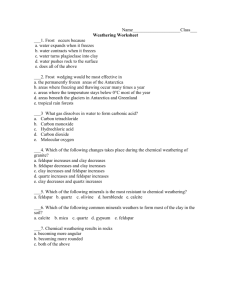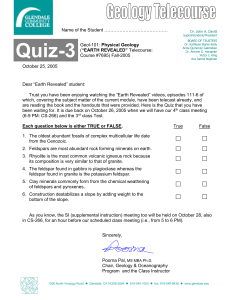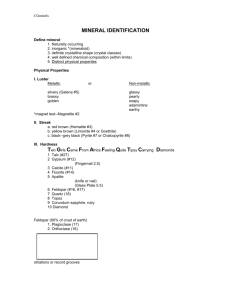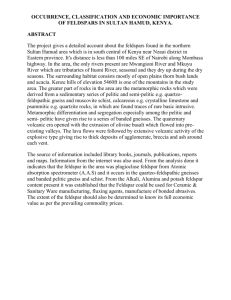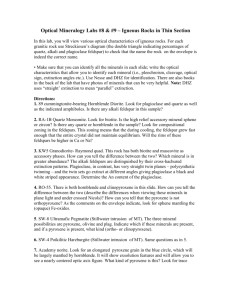IMPORTANT ROCK-FORMING MINERALS (or mineral identification
advertisement
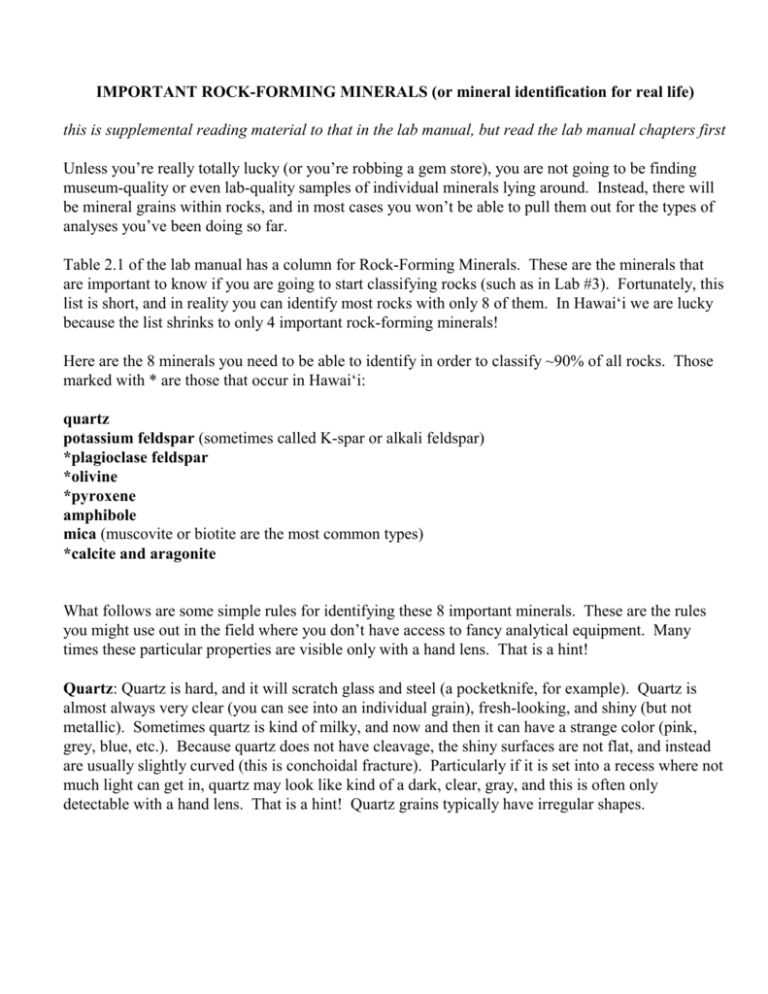
IMPORTANT ROCK-FORMING MINERALS (or mineral identification for real life) this is supplemental reading material to that in the lab manual, but read the lab manual chapters first Unless you’re really totally lucky (or you’re robbing a gem store), you are not going to be finding museum-quality or even lab-quality samples of individual minerals lying around. Instead, there will be mineral grains within rocks, and in most cases you won’t be able to pull them out for the types of analyses you’ve been doing so far. Table 2.1 of the lab manual has a column for Rock-Forming Minerals. These are the minerals that are important to know if you are going to start classifying rocks (such as in Lab #3). Fortunately, this list is short, and in reality you can identify most rocks with only 8 of them. In Hawai‘i we are lucky because the list shrinks to only 4 important rock-forming minerals! Here are the 8 minerals you need to be able to identify in order to classify ~90% of all rocks. Those marked with * are those that occur in Hawai‘i: quartz potassium feldspar (sometimes called K-spar or alkali feldspar) *plagioclase feldspar *olivine *pyroxene amphibole mica (muscovite or biotite are the most common types) *calcite and aragonite What follows are some simple rules for identifying these 8 important minerals. These are the rules you might use out in the field where you don’t have access to fancy analytical equipment. Many times these particular properties are visible only with a hand lens. That is a hint! Quartz: Quartz is hard, and it will scratch glass and steel (a pocketknife, for example). Quartz is almost always very clear (you can see into an individual grain), fresh-looking, and shiny (but not metallic). Sometimes quartz is kind of milky, and now and then it can have a strange color (pink, grey, blue, etc.). Because quartz does not have cleavage, the shiny surfaces are not flat, and instead are usually slightly curved (this is conchoidal fracture). Particularly if it is set into a recess where not much light can get in, quartz may look like kind of a dark, clear, gray, and this is often only detectable with a hand lens. That is a hint! Quartz grains typically have irregular shapes. 2 Potassium feldspar: Potassium feldspar (sometimes abbreviated as K-spar) almost always has kind of a milky, non-transparent look to it, and often you can see little wavy, milky veins (more properly called “exsolution lamellae”). There is a good photo of these lamellae in Fig. 1.21 of your lab book. Note that these lamellae are almost always lighter in tone than the surrounding part of the mineral, and although they may be somewhat parallel to each other, they are not perfectly straight or parallel. Potassium feldspar is usually whitish or reddish. It is common for potassium feldspar to exhibit one or more cleavage planes, and/or to be in grains with reasonably nice crystal forms. You can also find potassium feldspar grains that have completely irregular forms. Potassium feldspar is reasonably hard - it might scratch your knife. Plagioclase feldspar: Fresh plagioclase feldspar has a translucent to shiny-white appearance, so if you aren’t careful it can be confused with white potassium feldspar or clear quartz. However, a very key property of plagioclase feldspar is very straight and very parallel striations (lines) that are visible in all but the smallest grains. The far-right photo in Figure 2.1 shows these striations nicely (but faintly). Plagioclase feldspar is about as hard as potassium feldspar. Plagioclase feldspar can form irregularly-shaped grains, sometimes with a cleavage plane visible, or it can form elongate, prismaticlooking crystals with the elongation direction parallel to the cleavage and the striations. If plagioclase feldspar is weathered, it becomes chalky-white rather than translucent or shiny-white. Olivine: Olivine has a very distinctive olive-green color. It is usually a bit more yellowish than what is shown in Figure 2.8. Much more typical are the lighter-colored grains in Figure 3.11. Fresh olivines have a shiny clear appearance, but it doesn’t take much exposure to surface conditions and weathering for them to look a bit dull on the surface. These weathered surfaces may also have a slight red tint or they may also show the same play of colors that you see when there is oil on a wet road. Really weathered olivines are yellow-brown to rust colored. If it is an iron-rich olivine it may be almost black, but these are uncommon. Olivine crystals are can be irregularly shaped, but sometimes they show good form as slightly elongate, stubby crystals. Pyroxene: Pyroxene is actually a very dark green color but in most cases it appears black. It is typically somewhat shiny, and sometimes shows two cleavage planes that meet at ~90°. The cleavage planes are not really nice and smooth, however, and look more like lots of little, stepped, planes. Some pyroxene crystals show very nice ~diamond-like or triangular forms. Pyroxene weathers much more slowly than olivine and it is common to find fresh-looking pyroxenes and weathered-looking olivines in the same rock. The darker grains in Figure 3.11 are pyroxenes. Amphibole: Amphibole is also very dark green but almost always appears to be shiny and black. Unlike pyroxene, however, amphibole commonly forms elongate grains that are at least 2-3 times as long as they are wide. They sometimes look like short fat slivers. If you can view an amphibole crystal end-on, you should see a diamond shape formed from two cleavage planes that meet at 56° and 124° angles (see Figure 1.10 B of your lab book). Other times, amphibole just looks like little irregular black blobs filling in spaces between other minerals. In these cases it might be difficult to tell from biotite mica viewed on edge, except that biotite is very soft and can be scratched or broken easily. 3 Mica: Micas are usually easy to identify because they show one perfect cleavage plane that causes the grains to break into thin shiny sheets. Hold a rock at arms length and move its orientation - if you see bright winks of light, these are probably mica cleavage planes. Even small grains feature these sheets and they can be seen with a hand lens. Also, micas are soft, and you can scratch them sometimes with your fingernail and always with a pocket knife. The two most common micas are biotite, which is very dark brown to black, and muscovite, which is clear to dull silver (although it is not a metallic mineral). Micas viewed perpendicular to the cleavage plane often look hexagonal - think of mica as stacks of hexagonal sheets that you may be seeing face-on, edge-on, or any angle in between. Calcite and Aragonite: These two minerals are two forms of the same chemical composition calcium carbonate. Calcite and Aragonite can be formed by organic processes (limestone reefs and most sea shells are aragonite to begin with, but change naturally to calcite over time), and also by inorganic processes (beautiful calcite crystals often form in veins where water percolates through limestone). In the organic cases, individual mineral grains are almost always too small to distinguish, and the best thing to do to see if calcite or aragonite are present is to put a small drop of dilute HCl (hydrochloric acid) on the rock. If it fizzes, then probably you have some calcite or aragonite. Sometimes also, on a weathered limestone surface, you will see what looks like craggy ridges and grooves, kind of like a fingerprint (but more straight). This is often called “elephant-skin texture” and is diagnostic of limestone. Inorganic calcite has a distinctive rhombohedral form, and you may be able to detect parallel lines similar to those in plagioclase feldspar. a rhombohedron - note that sides and edges are parallel to opposite sides and edges, but that there are no right angles – see also Figure 1.11B in your lab book
